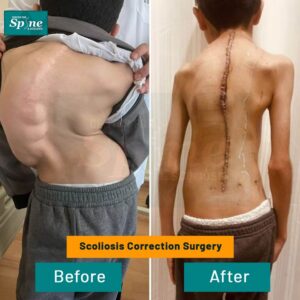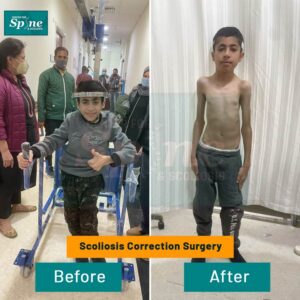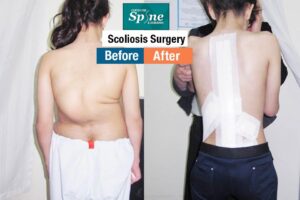How can we fully rectify severe spine deformities? Scoliosis? Kyphosis? Kyphoscoliosis?
If you or your child require treatment, your physician might recommend:




Orthoses
For children still undergoing growth, it is recommended to don an orthosis around the trunk to halt the progression of the curve. Typically constructed from plastic or other synthetic materials, these orthoses are custom-made based on precise measurements and adjustment requirements. Many children must wear them constantly, yet they don’t interfere with daily activities and remain concealed beneath clothing.
Highly effective for flexible deformities of idiopathic scoliosis with small to medium curves, these orthoses are periodically readjusted every six months to accommodate the child’s growth and reduce the curve.
Non-fusion Techniques
Non-fusion methods such as growing rods are specifically designed for idiopathic and congenital scoliosis. Employing minimally invasive procedures, these techniques facilitate both growth and curve correction. Utilizing either magnetic or non-magnetic growing rods, magnetic rods offer the advantage of distraction procedures in an outpatient setting without requiring biannual surgeries.
Spinal Fusion Surgery
In this procedure, bone fragments or similar materials are inserted between spinal bones to fuse them together. Implants like screws and rods are employed to stabilize the bones until fusion occurs. This surgery effectively reduces the angle of the deformed spinal curve and prevents further deterioration.
Complex Scoliosis Surgery for Children – An International Patient’s Experience
Baby Dalya Hardan: A Delighted International Patient post-Scoliosis Correction Surgery in India
Spinal fusion surgeries are typically performed after the age of 10 or 11, once the torso has fully matured, and lung development has progressed sufficiently. Providing a permanent solution, these surgeries maintain the corrected curve and prevent future deterioration.
Spine and Rib-Based Growth Procedures
This method corrects more severe scoliosis in growing children by attaching rods to the spine and ribs with implants. As the child grows, the length of the rods is adjusted. Patients experience minimal discomfort during hardware adjustments. This technique requires regular spaced distractions from the device, as the correction process is gradual and spans several years. Unlike fusion procedures, this approach allows continued torso growth and also provides space for lung expansion.
If the curve (Cobb’s angle) measures less than 40 degrees, full correction can be achieved through bracing and exercises. However, if the curve exceeds 40 degrees, surgery is necessary, involving spinal fixation (screws and rods placement), bone derotation, and sometimes osteotomy procedures.
Understanding Scoliosis
Scoliosis refers to a sideways curvature of the spine, typically first detected during childhood or adolescence. Any curvature exceeding 10 degrees on an X-ray constitutes scoliosis. Doctors classify curves using the letters “C” and “S”. A small curve measures less than 60 degrees, medium curves range from 60 to 90 degrees, and large curves exceed 90 degrees. Scoliosis may result from bony defects (congenital scoliosis), nerve or muscle issues (neuromuscular scoliosis), or may have no underlying pathology (idiopathic scoliosis).
Kyphosis
Kyphosis involves an excessive forward curvature of the spine, exceeding 60 degrees. This curvature causes the upper back to appear overly rounded, resulting in a hunched or slouched posture. Often referred to as ‘hunchback’ or ‘round back’, kyphosis may stem from infections, fractures, or bony abnormalities like fused or incomplete vertebrae. Age-related weakening of vertebrae and spinal fractures can also contribute to kyphosis.
Kyphoscoliosis
Kyphoscoliosis combines outward (kyphosis) and lateral (scoliosis) curvature of the spine.
Proven Techniques for Complete Spine Deformity Correction
Standard treatments for spinal deformities, ranging from non-surgical to surgical, include:
Observation and monitoring, especially in young children, to prevent progression of spinal curvature. Typically recommended for children under 10 years old with a Cobb’s angle less than 40 degrees.
Orthotic bracing to maintain spine alignment. Bracing facilitates gradual curve correction or stabilizes the curve until surgery.
Physical therapy and lifestyle adjustments to incorporate more exercise, strengthening back muscles. Children are encouraged to perform back and abdomen exercises to strengthen spine-supporting muscles, crucial for pre-surgery stabilization and post-surgery mobilization.
Ultimately, surgery is required for congenital curvature or curves exceeding 40 degrees in neuromuscular or idiopathic cases. Fusion surgeries involve procedures such as screw and rod placements, bone cuts (osteotomies), or vertebral column resections to strengthen the spine.
Surgical approaches for spinal deformities range from minimally invasive to complex, with surgery durations varying from 4 to 14 hours based on curve complexity and correction needs. Occasionally, surgeries are conducted in two stages, three days apart, particularly for procedures involving apex bone cuts (vertebral column resections).
Follow These Simple Steps
STEP 1: Share your X-ray film via WhatsApp to +91 9818560909.
STEP 2: Seek expert opinion from Dr. Hitesh Garg (Senior Consultant and Head of Spine Surgery at Artemis Hospital, Gurgaon).
STEP 3: Schedule an appointment at Artemis Hospital, Gurgaon by calling +91-9818560909.
STEP 4: Embrace a life free of deformities and taboos!
Click here to WhatsApp your X-ray. – Kindly Share X-ray/MRI Report with us.
Consequences of Delaying Treatment
Potential complications of delayed or avoided surgery include:
Respiratory issues, as severe mid-back curvature compresses the lungs, limiting expansion.
Inability to perform daily activities due to postural problems arising from spinal curvature. Progressive nerve and muscle weakness in the pelvis and lower limbs can exacerbate these issues over time.
Lower limb sensory loss, incontinence, or reduced sexual function due to lower back nerve compression. For curves exceeding 100 degrees, progressive paralysis may develop, sometimes rapidly, particularly in kyphoscoliotic deformities resulting from trauma or infection.
Back pain due to compressed spinal nerves or muscle spasms. As the curve progresses, facet joint and disc degeneration in the spine often lead to pain.
Severe curves exceeding 140 degrees may compress internal abdominal organs, causing difficulties in digestion and eating, along with symptoms like vomiting and abdominal pain.

